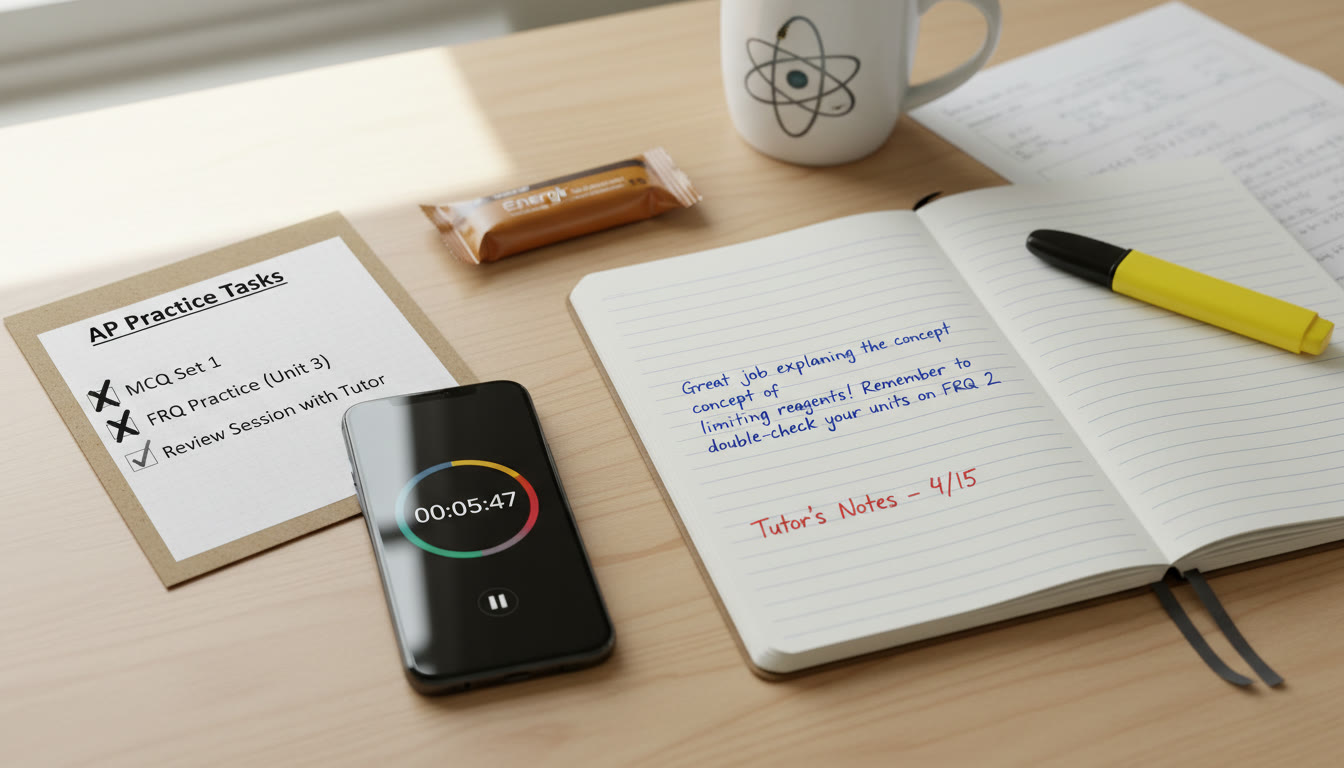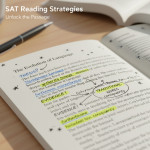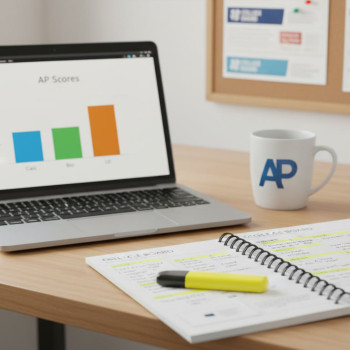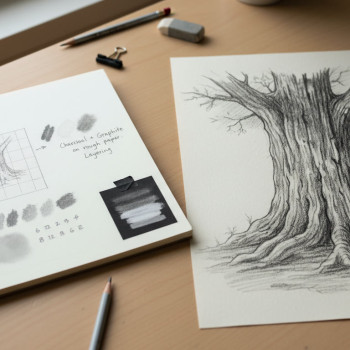Why Motivation Dips Are Normal — And Why Micro‑Wins Work
If you’re prepping for an AP exam, you’ve probably had this exact morning: you open your review book, stare at the first page, and your brain decides it’s the perfect time to rehearse every awkward conversation you’ve ever had. Motivation dips aren’t a sign you’re lazy or not cut out for APs — they’re a human response to sustained pressure, decision fatigue, and a brain that prefers short‑term comfort to long‑term goals.
Micro‑wins are tiny, intentionally designed successes that reverse that downward spiral. They’re small enough to be achievable in minutes, but they send a powerful message to your brain: progress is happening. For AP students, that can mean the difference between staring at a syllabus and actually mastering a concept.

What Counts as a Micro‑Win?
Micro‑wins are granular and measurable. They’re not “study until I’m ready” or “review a chapter” (which are vague and moveable). A micro‑win sounds like:
- Complete 10 AP Calculus practice derivatives in 20 minutes.
- Write a 150‑word outline for an AP US History LEQ.
- Summarize one AP Biology case study in 5 bullet points.
- Teach one concept back to a friend (or your mirror) for five minutes.
Each of these is specific, time‑bounded, and leaves a trace — a checked box, a saved file, or a sticky note. Those traces matter. They convert vague hope into visible progress.
How Micro‑Wins Restore Momentum: The Science, Briefly
Motivation isn’t an on/off switch. It’s a feedback loop. When you achieve something, your brain releases small boosts of reward chemicals and reduces the perceived distance to your goal. Micro‑wins supply those boosts frequently. Over days and weeks they compound into sustained momentum — and research in learning psychology shows that momentum increases engagement, persistence, and the quality of study sessions.
For AP students juggling coursework, extracurriculars, and maybe a job or family responsibilities, micro‑wins are an efficient way to squeeze progress out of limited time without burning out.
Real Benefits You’ll Notice Fast
- Shorter, more focused study sessions that consistently produce results.
- Reduced procrastination because tasks feel manageable.
- Improved confidence — you’ll point to a growing list of wins.
- Better retention, because repeated retrieval practice is built into mini‑tasks.
Designing Your Micro‑Win System: A Student‑Friendly Framework
Here’s a practical framework to create a micro‑win system that fits into the chaos of a high school day.
Step 1 — Define Your Big Goal
Be concrete. Instead of “do well on AP Biology,” say “score a 5 on AP Biology in May by covering every unit and mastering 75% or more of released multiple‑choice items and 4/6 on free response practice.” The big goal gives direction — micro‑wins are the stepping stones.
Step 2 — Break It Into Tiny Actions
For each unit or skill, list actions that take 10–30 minutes. Example for AP English Language: one micro‑win could be “annotate one essay passage and write a 120‑word analysis focusing on rhetorical strategies.”
Step 3 — Schedule Micro‑Wins, Not Hours
It’s easier to commit to “two micro‑wins after dinner” than “study for two hours.” Put micro‑wins on your calendar as short, nonnegotiable appointments.
Step 4 — Track and Celebrate
Create a simple tracker — a notebook, a habit app, or a sticky note grid. Celebrate small wins: cross them off, share them with a study buddy, or reward yourself with 10 minutes of something you love.
Examples: Micro‑Win Plans for Popular AP Subjects
Below are sample micro‑win plans you can adapt to your schedule and skill level. Each plan contains repeated, short practices designed to build mastery and confidence.
| AP Subject | Sample Micro‑Win | Frequency | Why It Helps |
|---|---|---|---|
| AP Calculus AB | Complete five derivative problems + 5‑minute concept summary | Daily (20–30 min) | Builds procedural fluency and quick conceptual recall |
| AP US History | Write a 3‑point thesis + two evidence bullets for one unit topic | 4× a week (15–20 min) | Improves argument structure and evidence recall |
| AP Biology | Summarize one experiment or process in 6 bullets + draw a quick diagram | 3× a week (20–30 min) | Connects theory to visualization for better retention |
| AP English Language | Annotate one passage and write a 120‑word rhetorical analysis | Daily (15–25 min) | Sharpen analytical reading and concise writing |
Sample Week: Turning Micro‑Wins into a Habit
Here’s a realistic student schedule that blends classes, activities, and micro‑wins. Adjust times to your routine.
- Monday — 4:30 pm: 20 minutes — AP Calculus micro‑win (5 problems + summary).
- Tuesday — 8:00 pm: 25 minutes — AP US History micro‑win (thesis + evidence).
- Wednesday — 7:30 pm: 20 minutes — AP Biology micro‑win (experiment summary).
- Thursday — 9:00 pm: 15 minutes — AP English Lang micro‑win (passage annotation).
- Friday — 6:00 pm: 30 minutes — Mixed practice: two micro‑wins in a row + review tracker.
- Weekend — 60–90 minutes block: do 3–4 micro‑wins with one timed practice set.
Notice two things: first, you aren’t extinguishing your social life; second, focused weekend blocks let you depth‑practice while weekdays preserve momentum.
Tools and Tactics That Make Micro‑Wins Easier
Micro‑wins thrive on structure and small incentives. Try these low‑friction tools and tactics:
- Timer technique: Use a 20‑minute countdown to start each micro‑win. Begin that timer the moment you sit down.
- Visible tracker: Keep a paper list or whiteboard and cross off each micro‑win. The visual progress is motivating.
- Accountability buddy: Swap daily micro‑win check‑ins with a friend or classmate.
- Smart rewards: After three consecutive days of wins, treat yourself to something meaningful but light (favorite snack, 30‑minute walk, or a hobby session).
How Personalized Tutoring Amplifies Micro‑Wins
Micro‑wins are powerful, but they’re even more effective with targeted feedback. Personalized tutoring — for example, Sparkl’s 1‑on‑1 guidance and tailored study plans — can help you choose micro‑wins that address your unique weaknesses, ensures practice is aligned to AP exam expectations, and provides expert feedback that turns small wins into lasting competence. When micro‑wins target the exact concepts you struggle with, the speed of improvement accelerates.
Common Pitfalls and How to Avoid Them
Micro‑wins are simple, but students sometimes sabotage them without realizing it. Here are common mistakes and quick solutions.
Pitfall 1: Micro‑Wins Are Too Big or Vague
Solution: Make them smaller and measurable. “Study chemistry” becomes “complete 8 stoichiometry practice problems with solutions checked and note one error type.”
Pitfall 2: No Feedback Loop
Solution: Always pair a micro‑win with a feedback step. That could be comparing answers to a key, asking a tutor one question, or teaching the concept back to someone.
Pitfall 3: Rewarding Too Much or Too Little
Solution: Keep rewards proportional. A micro‑win earns a short, immediate reward (5–10 minutes of something you enjoy). Save larger rewards for milestones — finishing a unit of study, hitting a month of consistency, etc.
When Motivation Is Low for Real — Not Just a Dip
Sometimes what feels like a motivation dip is actually burnout, anxiety, or a poor fit between study methods and learning style. Signs include chronic exhaustion, dread instead of challenge, or complete avoidance. If you notice these, adjust your approach:
- Scale back intensity: replace a 90‑minute study block with two or three micro‑wins.
- Change modalities: switch passive reading to active retrieval (flashcards, teach‑back, practice tests).
- Get targeted help: a tutor can identify gaps, recommend micro‑wins tailored to weak skills, and restore confidence.
Again, that’s where personalized services like Sparkl can fit naturally: short, focused sessions to reignite clarity and design micro‑win routines that match your current energy.
Measuring Progress: A Simple Micro‑Win Dashboard
Tracking isn’t just for completion — it’s for insight. Use this dashboard idea to keep data on what works.
| Date | Micro‑Win | Time Spent | Success (Y/N) | Confidence (1–5) | Notes / Next Micro‑Win |
|---|---|---|---|---|---|
| Oct 1 | 5 Calc derivatives | 20 min | Y | 4 | Need more chain rule practice |
| Oct 2 | APUSH thesis practice | 15 min | N | 2 | Review rubric; tutor checkpoint |
This keeps study objective and highlights patterns. If your confidence is low despite consistent wins, it’s a cue to seek targeted feedback — that’s an efficient use of a tutor’s time.
Personal Stories — Short Wins, Big Returns
Imagine Maya, a junior juggling AP Chemistry and track. She spent two weeks dreading lab reports and then set a micro‑win: “Finish one paragraph of the lab conclusion in 15 minutes.” She did it every evening for a week and gradually increased to two paragraphs. Within a month, her lab writing improved, she had fewer late submissions, and — most importantly — she felt capable again.
Or Jay, who could not finish an AP Spanish reading on time. He replaced two‑hour review sessions with 20‑minute micro‑wins focused on 100 high‑frequency vocabulary words and one timed reading passage. His speed and accuracy climbed because each micro‑win targeted a single bottleneck.
These are small stories with big lessons: micro‑wins treat motivation as a renewable resource, not an emotional roller coaster.

Putting It Together: A 30‑Day Micro‑Win Challenge
Try a 30‑day challenge to rebuild momentum. Here’s a suggested template you can tweak:
- Week 1 — Commitment: Choose 3 micro‑wins (one per subject). Do each micro‑win 4× this week. Track daily.
- Week 2 — Consistency: Keep doing the micro‑wins. Add one feedback step per micro‑win (self‑check or tutor review).
- Week 3 — Intensify with Variety: Add one mixed practice session (two micro‑wins back‑to‑back) and one timed set.
- Week 4 — Reflect and Scale: Review the dashboard, celebrate progress, and design next month’s micro‑wins to stretch slightly beyond comfort zone.
By the end of 30 days you’ll either have a new habit or a clear roadmap for the next phase of study. If progress stalls, a quick 1‑on‑1 session with an expert tutor can recalibrate micro‑wins so they’re pointing at the most impactful weaknesses.
Final Notes: Gentle Consistency Beats Intense Sprints
AP prep is a marathon of learning, not a single race. Micro‑wins are your mile markers: visible, motivating, and repeatable. They help you win the small battles that lead to the exam‑day victory you want. Start tiny, track honestly, and adjust with smart feedback. Personalized tutoring and tailored study plans — like those Sparkl provides — can speed this process by pinpointing the right micro‑wins and giving timely corrections.
So tomorrow, when motivation feels thin, pick one micro‑win you can do in 20 minutes. Set the timer. Do it. Check it off. That single small success might be the spark that turns your whole week around.
A Quick Checklist to Start Now
- Choose one AP course and write a concrete big goal.
- Create three micro‑wins for that course (10–30 minutes each).
- Schedule at least four micro‑wins this week on your calendar.
- Use a simple tracker and give yourself a short reward after each win.
- After a week, review progress and ask for targeted help if needed.
Small steps, repeated. That’s how big scores are built — and how motivation becomes sustainable. You’ve got this.
























No Comments
Leave a comment Cancel